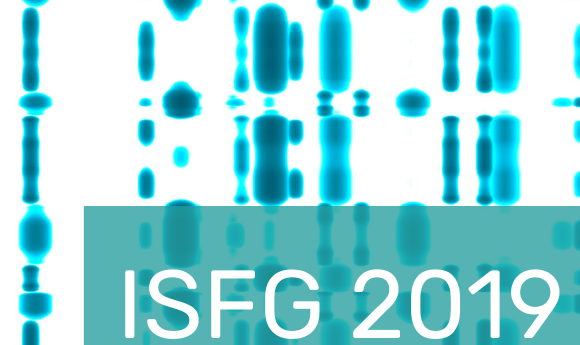ISFG 2019 conference report

The 28th International Congress of the International Society for Forensic Genetics (ISFG), took place in Prague (Czech Republic) on 9-13 September 2019. The meeting aimed to promote scientific knowledge in the field of genetic markers as applied to forensic science.
Forensic science is continually being challenged. Twenty-five years ago, PCR-based methods revolutionized the field, bringing DNA-based methods into crime scene analysis and into the court room. The repercussions are still being felt today; forensic DNA analysis is now a mature field and is struggling with the consequences of its own success – increased sensitivity, speed and amounts of available data bring opportunity but some complications for investigators. These were a common theme of the recent biannual ISFG meeting.
From forensic genetics to forensic genealogy
The elephant in the room was the arrest last year of Joseph James DeAngelo, the Golden State Killer, using the new and burgeoning field of Forensic Genealogy. Up until now a DNA match required a matching profile in a pre-existing database. Now, investigators can use public DNA databases, construct family trees and find a suspect using a mixture of genealogical tools and grunt work. This is possible because of the massive amount of individual DNA data submitted to recreational DNA databases. The odds that a missing person or a suspect has a relative in these databases are now quite high.
The potential of this approach is compelling. Many historical crimes can now be revisited. Many talks examined the potential of this technique and shared part of the growing list of casework examples. There is no doubt this will be a major investigative tool, particularly for cold cases. However, Chris Phillips from the University of Santiago de Compostela (Spain) outlined some concerns. Technically, standards need to be set to deal with DNA mixtures, low quality DNA and accreditation issues. Legal and ethical issues also need to be addressed. The technology may become commonplace, cheaper and used for other goals such as lower level crime and surveillance.
DNA Transfer and the challenge of increased sensitivity
The other major consequence of increased sensitivity is DNA transfer. In December 2012 in San Jose (CA, USA), Lukis Anderson was arrested for the murder of Raveesh Kumra after his DNA was discovered at the crime scene. Unfortunately, Anderson was in hospital at the time of the murder, a fact that came out only after he had been arrested. In Anderson’s case, EMTs carried his DNA to the crime scene. If he did not have an unimpeachable alibi, he may well have been convicted. DNA typing is now so sensitive that it can be detected from biological particles that transfer from one person to another.
Roland van Oorschot of the Victoria Police in Australia and his European collaborators are trying to explore and systemize the process of DNA transfer and discriminate between incidental and actual crime scene DNA. Instead of asking whom this DNA profile belongs to, investigators are now asking how the DNA arrived at the crime scene, which should have been the question all along.
Greater sensitivity also results in mixtures. Investigators often see DNA from several contributors in a touch or other samples. Resolving these mixtures and calculating likelihood ratios is tricky. The last few years have seen the development of some software tools to help with this problem, such as TrueAllele (Cybergenetics, PA, USA) and STRMix (OH, USA), and come up with statistically rigorous answers. Getting consistent results between these software packages has been a challenge. New software packages, validation protocols and new applications of probabilistic genotyping were reported on at the conference.
- Can modern DNA sequencing solve history’s greatest murder mystery?
- Monster-hunting scientists could have solved the legend of Loch Ness
- Crime-solving: it’s in the genes
Massively parallel sequencing and SNPs
The use of massively parallel sequencing helps here. Scientists now realize that the common DNA-typing alleles often hide additional variation. What was thought to be one short tandem repeat allele actually may be many. In the future this will help sort out the number and contributors in complex mixtures. It also brings some challenges as well. How should we name these new alleles? How do we fit these additional data in our models for how populations work? Katherine Gettings of the National Institute of Standards and Technology (MD, USA), is leading an international effort to systematize nomenclature. Peter De Knijff of Lieden University (The Netherlands) described the first conviction using massively parallel sequencing.
Massively parallel sequencing is also opening up the world of DNA single nucleotide polymorphisms (SNPs). These SNPs play a role in our appearance and these were the focus of several talks, including the inaugural lecture given by the 2017 ISFG prizewinner, Manfred Keyser of Erasmus University (Rotterdam, The Netherlands). SNPs are stable and small, so they will be present in a forensic sample long after longer DNA sequences are degraded. With this in mind, several groups, particularly Kenneth Kidd of Yale University (CT, USA), are identifying candidate SNPs or SNP combinations to provide identifying and ancestral information. These are now in commercial kits and both phenotypic and identifying SNPs are being developed for use by investigators.
Shifting the focus from DNA
For decades the focus of forensic science and forensic genetics has been on DNA. Over that time, major advances have also occurred in epigenetics, transcriptomics and proteomics. These fields are now beginning to have an impact. Methylation patterns in DNA have information on tissue source, age and personal behavior, such as smoking. Jack Ballantyne, from the University of Central Florida (FL, USA), gave a lecture on transcriptomics that can also be used to identify body fluids and deconvolute mixtures. Proteomic genotyping, the focus of a talk by this correspondent, is now demonstrated to be a source of useful forensic information in the form of profiles of genetically variant peptides that allow a genotype to be developed in the absence of DNA template.
Forensic science continues to grow in terms of scope, information and sophistication. The field is maturing with increased awareness of limitations and potential pitfalls. Forensic genetics is also beginning to take to take advantage of other tools such as epigenetics, transcriptomics and proteomics. It will be interesting to see what advances will occur over the next 2 years before we meet again at the 29th ISFG Congress, set to be held in Washington DC (DC, USA).

